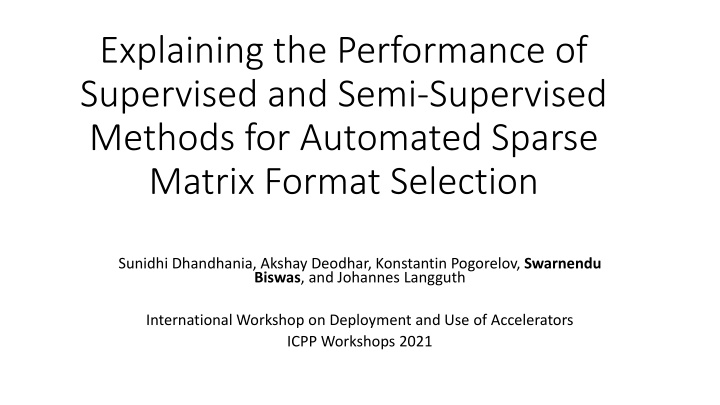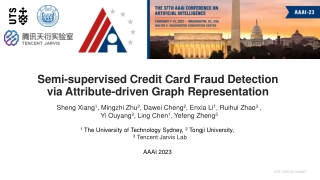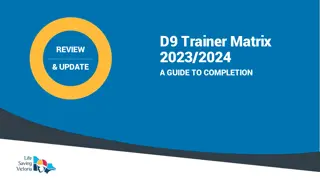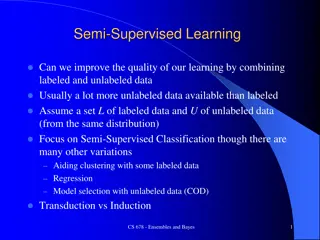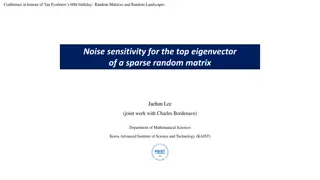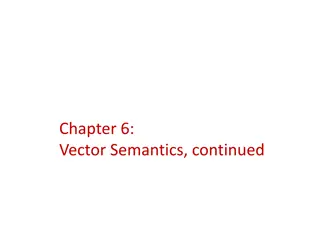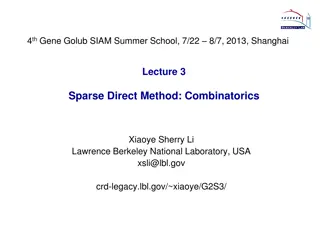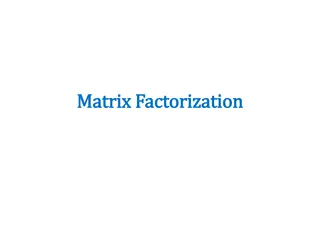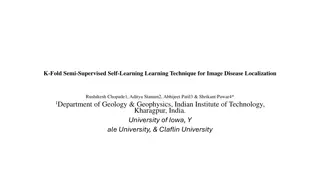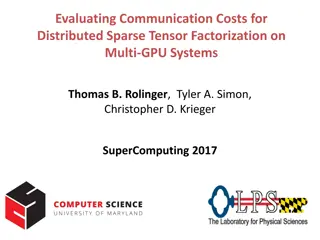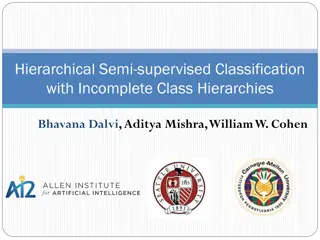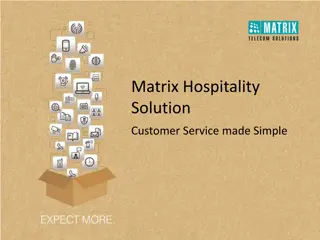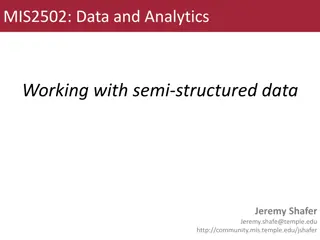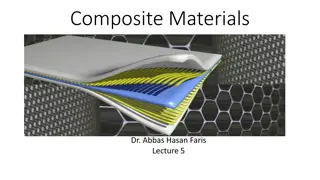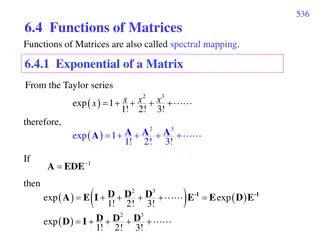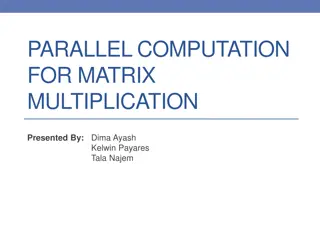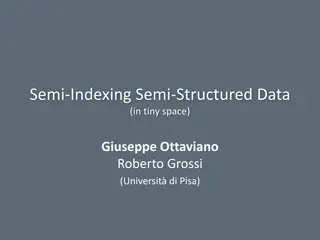Performance of Supervised and Semi-Supervised Methods for Sparse Matrix Selection
This paper discusses the performance of supervised and semi-supervised methods for automated sparse matrix format selection in the context of accelerators. The study was presented at the International Workshop on Deployment and Use of Accelerators. The authors compare and analyze the effectiveness of different approaches in solving sparse matrix-related problems.
Download Presentation

Please find below an Image/Link to download the presentation.
The content on the website is provided AS IS for your information and personal use only. It may not be sold, licensed, or shared on other websites without obtaining consent from the author.If you encounter any issues during the download, it is possible that the publisher has removed the file from their server.
You are allowed to download the files provided on this website for personal or commercial use, subject to the condition that they are used lawfully. All files are the property of their respective owners.
The content on the website is provided AS IS for your information and personal use only. It may not be sold, licensed, or shared on other websites without obtaining consent from the author.
E N D
Presentation Transcript
Explaining the Performance of Supervised and Semi-Supervised Methods for Automated Sparse Matrix Format Selection Sunidhi Dhandhania, Akshay Deodhar, Konstantin Pogorelov, Swarnendu Biswas, and Johannes Langguth International Workshop on Deployment and Use of Accelerators ICPP Workshops 2021
Sparse Matrix Vector Multiplication (SpMV) Important computation kernel PageRank, Conjugate Gradient, and Indirect solvers for systems of linear equations 1.0 - 2.0 - 3.0 1 22 22 - 4.0 - 5.0 - 2 28 = - - 6.0 - - 3 18 7.0 - - 8.0 - 4 39 - 9.0 - - - 5 18 ? ? ? J Greathouse and M Daga. Efficient Sparse Matrix-Vector Multiplication on GPUs using the CSR Storage Format. AMD Research 2014. ICPP Workshop 2021
Performance of SpMV Memory accesses are unstructured and have irregular access patterns unlike dense matrix operations Limited data reuse, FLOPS/byte is very low memory-bound Performance is sensitive to Sparsity pattern of the input matrix Processor microarchitecture and memory hierarchy Kernel implementation Other aspects like the Compiler and OS ICPP Workshop 2021
Sparse Matrix Formats Representing matrices in a sparse format result in significant memory savings MKL from Intel and CUSP and cuSparse from NVIDIA support many popular formats DIA ELL CSR COO HYB Structured Unstructured N. Bell and M. Garland. Sparse Matrix-Vector Multiplication on Throughput-Oriented Processors. NVIDIA Research. ICPP Workshop 2021
Sensitivity to Sparse Formats Slowdown (relative) Optimal Format Pascal Turing Volta Pascal Turing Volta mawi_201512012345 164.8 194.8 121.3 HYB HYB HYB lp_osa_60 5.2 8.8 7.5 HYB COO COO CSR format is used as the default CUSP library was used for benchmarking mawi_201512012345 Rows 18571154 Column 18571154 Nonzeros 38040320 Mean nonzeros per row 2.04 Max nonzeros in a row 16399896 Average std dev of nonzeros across rows 3805.8 ICPP Workshop 2021
Sensitivity to Sparse Formats Slowdown (relative) Optimal Format Pascal Turing Volta Pascal Turing Volta mawi_201512012345 164.8 194.8 No single format is the best across all input matrices and all target architectures 121.3 HYB HYB HYB lp_osa_60 5.2 8.8 7.5 HYB COO COO CSR format is used as the default CUSP library was used for benchmarking mawi_201512012345 Rows 18571154 Column 18571154 Nonzeros 38040320 Mean nonzeros per row 2.04 Max nonzeros in a row 16399896 Average std dev of nonzeros across rows 3805.8 ICPP Workshop 2021
Features Supervised ML Techniques Labels ML Model Train supervised ML models Training data set Trained ML Models Sparse matrix data set Profile data Benchmark SpMV kernels Sparse format prediction Target Architecture (e.g., Intel Xeon, NVIDIA Quadro) Test data set optimal sparse format ICPP Workshop 2021
Challenges with Supervised Methods Need representative training data and accurate feature set Compare the size of ImageNet and SuiteSparse! Numerical computations are being parallelized across heterogeneous compute devices Trained models are specific to the profiled architecture, need to retrain for all possible target architectures 90.65% accuracy 1.07X speedup 71% accuracy 0.97X speedup GeForce GTX 1080 Volta V100 ICPP Workshop 2021
Challenges with Supervised Methods May need to retrain if new sparsity patterns are found or new sparse formats are proposed Several new sparsity formats have been recently proposed (e.g., CVR, CSR5, CSR2, and PELLR) Training supervised ML models require benchmarking ? matrices ? formats ? trials, which will often run into days Overhead comes from reading matrix files and format conversion ICPP Workshop 2021
Desired Requirements for Automated Sparse Format Selection Solution should not be tightly coupled to the target architecture Model should be easily portable to different target hardware Approach should be flexible to incorporate new data Techniques should aim for the train once, deploy multiple times paradigm ICPP Workshop 2021
DL Techniques for Automated Format Selection CNNs have had great success in image classification and computer vision Why not use CNNs for classifying matrices? Y. Zhao et al. Bridging the Gap between Deep Learning and Sparse Matrix Format Selection. PPoPP 2018. J. Pichel and B. Pateiro-Lopez. A New Approach for Sparse Matrix Classification Based on Deep Learning Techniques. CLUSTER 2018. ICPP Workshop 2021
Do the DL Techniques Address the Challenges? DL models require even larger datasets to have good accuracy Training and inference is very costly compared to non-DL models W. Zhou et al. Enabling Runtime SpMV Format Selection through an Overhead Conscious Method. TPDS 2020. ICPP Workshop 2021
Our Proposal Semi-Supervised Method for Automated Sparse Matrix Format Selection ICPP Workshop 2021
Semi-Supervised Format Selection via Clustering Create clusters to identify matrices with similar execution characteristics Benchmark a few matrices from each cluster to assign a label Quality of cluster ? ???? ?????(?,?) |?| ??????? ? = ?????(?,?) gives the number of matrices in cluster ? having format ? ICPP Workshop 2021
Devising an Accurate Clustering and Labeling Scheme Na ve application of K-Means clustering gives poor results Our pipeline Apply transformations (log or square root) to the feature set Apply Min-max scaling to scale each feature to [0,1] Use PCA to decompose the features to a vector of size 8 How to find K? More small clusters will increase accuracy Few large clusters reduces training time and limits overfitting, but can be more inaccurate ICPP Workshop 2021
Dissecting Clustering-based Format Selection Clusters will be invariant across platforms (ideal) Assignment of labels to clusters is platform-specific Benefits Easy to port the model to a different architecture Easy to include new sparse formats K-Means Majority Vote Mean-Shift Logistic Regression BIRCH Random Forest ICPP Workshop 2021
Implementation and Platforms Implemented sparse format selection techniques with scikit- learn and TensorFlow libraries Used CUDA Toolkit 9.2 and CUSP library from NVIDIA Pascal Volta Turing Model GTX 1080 V100 SXM3 RTX 8000 # SMs 20 80 72 Memory (GB) 8 (GDDR5) 32 (HBM2) 48 (GDDR6) Memory bandwidth 320 GB/s 897 GB/s 672 GB/s ICPP Workshop 2021
Performance of Semi-Supervised Approaches in Local Setting # Clusters MCC ACC (%) F1 K-Means + VOTE 300 0.629 88.2 0.877 K-Means + LR 150 0.537 86.0 0.845 K-Means + RF 200 87.5 0.873 0.631 Mean-Shift + VOTE 30 0.137 79.2 0.710 Mean-Shift + LR 30 0.111 79.0 0.705 Mean-Shift + RF 30 0.145 79.3 0.713 BIRCH + VOTE 150 0.622 88.1 0.874 BIRCH + LR 100 0.354 82.2 0.777 BIRCH + RF 200 0.628 87.9 0.874 ICPP Workshop 2021
Performance of Supervised Approaches in Local Setting # Slowdown 1.5X MCC ACC (%) F1 GT CSR DT 0.83 94.36 0.94 0.99 1.05 17 RF 0.85 95.04 0.95 1 1.05 11 SVM 0.81 93.85 0.94 0.99 1.04 21 KNN 0.85 94.81 0.95 0.99 1.05 15 XGBoost 0.87 95.62 0.96 1 1.05 11 CNN 0.72 90.45 0.94 0.98 1.04 14 ICPP Workshop 2021
Performance of Semi-Supervised Approaches in Transfer Setting # Clusters 0% Training Data 25% Training Data MCC ACC (%) F1 MCC ACC (%) F1 K-Means+VOTE 1250 0.605 86.6 0.870 0.638 88.1 0.880 K-Means+LR 125 0.582 87.2 0.861 0.592 87.5 0.863 K-Means+RF 200 0.630 87.3 0.872 0.642 87.3 0.874 BIRCH+VOTE 175 0.593 86.4 0.866 0.610 0.878 0.871 BIRCH+LR 100 0.482 84.9 0.825 0.544 0.862 0.847 BIRCH+RF 200 0.611 87.2 0.869 0.613 0.879 0.870 ICPP Workshop 2021
Performance of Supervised Approaches in Transfer Setting 0% Training Data 25% Training Data MCC ACC (%) F1 GT CSR MCC ACC (%) F1 GT CSR DT 0.55 81.06 0.82 0.97 1.03 0.65 86.99 0.87 0.98 1.04 RF 0.70 88.94 0.89 0.63 84.85 0.86 0.98 1.04 0.96 1.05 SVM 0.64 85.49 0.86 0.98 1.04 0.68 88.04 0.88 0.98 1.04 KNN 0.46 76.23 0.78 0.95 1.01 0.54 81.08 0.83 0.96 1.02 XGBoost 0.49 77.47 0.79 0.96 1.02 0.97 1.03 0.60 83.58 0.85 ICPP Workshop 2021
Key Takeaways Semi-supervised approaches for sparse format selection can be competitive with supervised approaches Explore additional techniques to improve the performance of semi- supervised methods Provides several desirable benefits including easy model portability, easy to include new data, and extend to a runtime with online learning ICPP Workshop 2021
Explaining the Performance of Supervised and Semi-Supervised Methods for Automated Sparse Matrix Format Selection Sunidhi Dhandhania, Akshay Deodhar, Konstantin Pogorelov, Swarnendu Biswas, and Johannes Langguth DUAC, ICPP Workshops 2021
